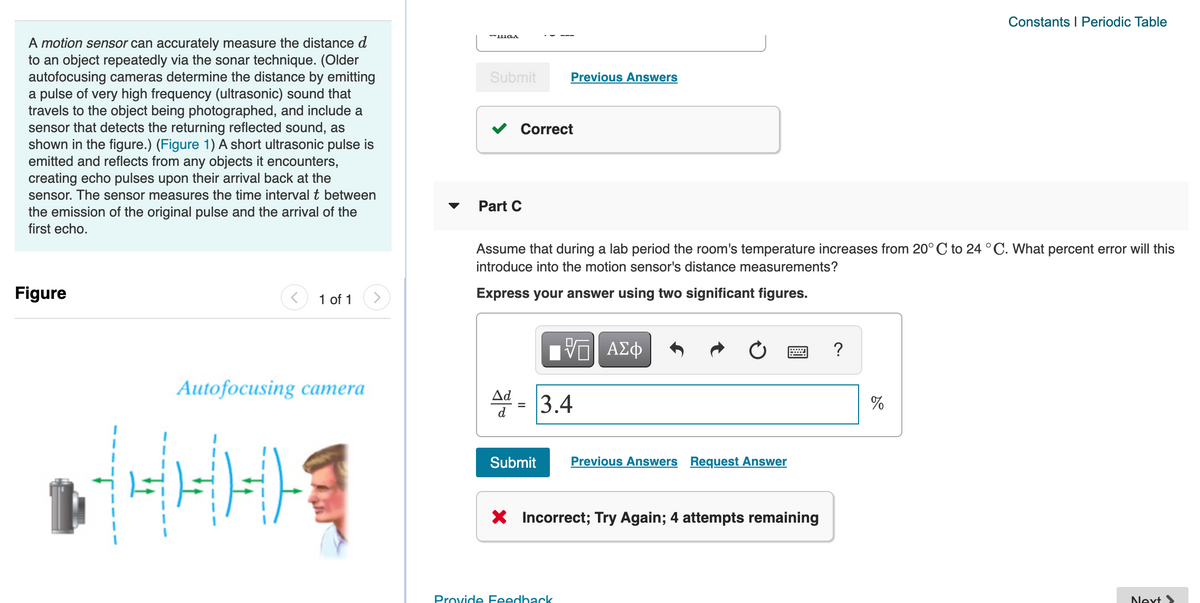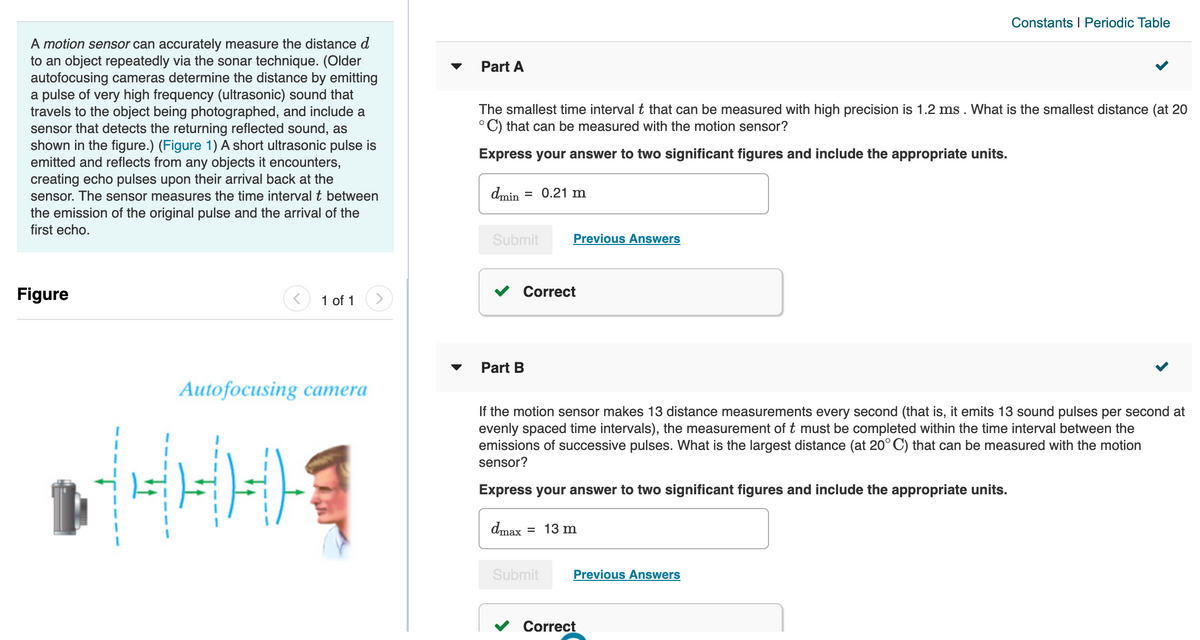University Physics Volume 1
18th Edition
ISBN:9781938168277
Author:William Moebs, Samuel J. Ling, Jeff Sanny
Publisher:William Moebs, Samuel J. Ling, Jeff Sanny
Chapter16: Waves
Section: Chapter Questions
Problem 43P: (a) Seismographs measure the arrival times of earthquakes with a precision of 0.100 s. To get the...
Related questions
Concept explainers
Question
I got parts A and B correct, but my answer for part C is wrong. Need help with part C pls.

Transcribed Image Text:Constants I Periodic Table
A motion sensor can accurately measure the distance d
to an object repeatedly via the sonar technique. (Older
autofocusing cameras determine the distance by emitting
a pulse of very high frequency (ultrasonic) sound that
travels to the object being photographed, and include a
sensor that detects the returning reflected sound, as
shown in the figure.) (Figure 1) A short ultrasonic pulse is
emitted and reflects from any objects it encounters,
creating echo pulses upon their arrival back at the
sensor. The sensor measures the time interval t between
the emission of the original pulse and the arrival of the
Submit
Previous Answers
Correct
Part C
first echo.
Assume that during a lab period the room's temperature increases from 20°C to 24 °C. What percent error will this
introduce into the motion sensor's distance measurements?
Figure
1 of 1
Express your answer using two significant figures.
?
Autofocusing camera
Ad
3.4
%
d
Submit
Previous Answers Request Answer
X Incorrect; Try Again; 4 attempts remaining
Provide Feedback
Next

Transcribed Image Text:Constants I Periodic Table
A motion sensor can accurately measure the distance d
to an object repeatedly via the sonar technique. (Older
autofocusing cameras determine the distance by emitting
a pulse of very high frequency (ultrasonic) sound that
travels to the object being photographed, and include a
sensor that detects the returning reflected sound, as
shown in the figure.) (Figure 1) A short ultrasonic pulse is
emitted and reflects from any objects it encounters,
creating echo pulses upon their arrival back at the
sensor. The sensor measures the time interval t between
the emission of the original pulse and the arrival of the
first echo.
Part A
The smallest time interval t that can be measured with high precision is 1.2 ms . What is the smallest distance (at 20
°C) that can be measured with the motion sensor?
Express your answer to two significant figures and include the appropriate units.
dmin
= 0.21 m
Submit
Previous Answers
Figure
1 of 1
Correct
Part B
Аutofocusing сатera
If the motion sensor makes 13 distance measurements every second (that is, it emits 13 sound pulses per second at
evenly spaced time intervals), the measurement of t must be completed within the time interval between the
emissions of successive pulses. What is the largest distance (at 20° C) that can be measured with the motion
sensor?
Express your answer to two significant figures and include the appropriate units.
dmax
= 13 m
Submit
Previous Answers
Correct
Expert Solution
This question has been solved!
Explore an expertly crafted, step-by-step solution for a thorough understanding of key concepts.
Step by step
Solved in 2 steps with 2 images

Knowledge Booster
Learn more about
Need a deep-dive on the concept behind this application? Look no further. Learn more about this topic, physics and related others by exploring similar questions and additional content below.Recommended textbooks for you

University Physics Volume 1
Physics
ISBN:
9781938168277
Author:
William Moebs, Samuel J. Ling, Jeff Sanny
Publisher:
OpenStax - Rice University

Glencoe Physics: Principles and Problems, Student…
Physics
ISBN:
9780078807213
Author:
Paul W. Zitzewitz
Publisher:
Glencoe/McGraw-Hill

Physics for Scientists and Engineers, Technology …
Physics
ISBN:
9781305116399
Author:
Raymond A. Serway, John W. Jewett
Publisher:
Cengage Learning

University Physics Volume 1
Physics
ISBN:
9781938168277
Author:
William Moebs, Samuel J. Ling, Jeff Sanny
Publisher:
OpenStax - Rice University

Glencoe Physics: Principles and Problems, Student…
Physics
ISBN:
9780078807213
Author:
Paul W. Zitzewitz
Publisher:
Glencoe/McGraw-Hill

Physics for Scientists and Engineers, Technology …
Physics
ISBN:
9781305116399
Author:
Raymond A. Serway, John W. Jewett
Publisher:
Cengage Learning

College Physics
Physics
ISBN:
9781938168000
Author:
Paul Peter Urone, Roger Hinrichs
Publisher:
OpenStax College